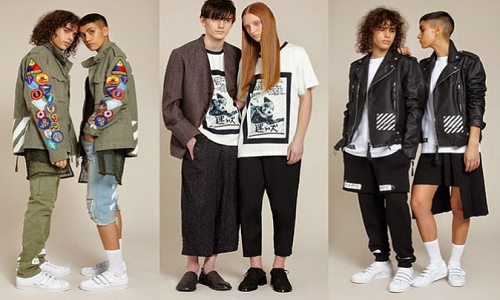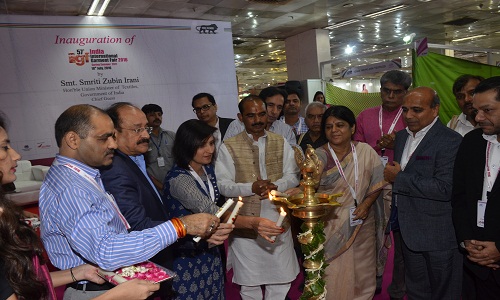FW
American clothing retailers are going through bad times as a number of Department stores such as Macy’s continue to struggle. So much so that specialty apparel stores like J.Crew and Gap are in a scornful mood. All this because shoppers are seen getting close to off-price stores selling goods that are permanently on sale.
A recent (July 14) report by research firm NPD Group found that 75% of US apparel purchases across all retail channels come from shoppers who also shop for clothing at off-price stores such as Marshalls, TJ Maxx and Ross.
Looking at it in another way, if 100 people walk into a Macy’s, 75 of them are also off-price clothing shoppers. That means Macy’s and other US clothing retailers are vying directly for most of their customers with competitors who only sell at a discount.
The NPD report also found that visits to off-price retailers increased 4% in the year through April 2016 compared to the same period last year. During that time, half of those visits led to a purchase.
Many department stores have created their own discount channels to capture these customers though results have been all that satisfactory. While Nordstrom’s offshoot, Nordstrom Rack has performed well, Saks Fifth Avenue’s and Bloomingdale’s outlets have had to go through harder times.
This increase of off-price retailers as well as fast fashion is also the reason of downward pricing pressure that’s making clothes on the low end of retail ever cheaper.
While the data on visits comes from NPD’s Shopper Insights Service, most of NPD’s data comes from its Checkout Tracking Service.
Other Checkout Tracking data not included in the report shows that US consumers of all sorts including buyers of high-end luxury goods are selective on prices and are willing to visit different types of stores in search of deals.
Origin Africa will be held in Madagascar, November 3 to 5, 2016.
This is Africa’s premier trade show. It highlights the creativity and innovation of the African cotton, textile, clothing industries, home décor, machinery and technology, with a specific focus on business, trade and investment both regionally and internationally while capturing the spirit, style and innovation of modern Africa.
There will be seminars and informative discussions on a wide range of current topics. The show will be attended by sourcing professionals and buyers from SADC, Europe, US and other important markets. There will be African and international exhibitors. The 2015 event had over 180 exhibitors from 25 countries.
Encouraging investment conditions are making Africa the next major sourcing destination.
Origin Africa is an ongoing effort dedicated to improving the African cotton, textile and apparel trade. It involves collaboration with producers across the cotton value chain from farm to fashion including accessories suppliers, home textile and décor to develop, guide and promote African trade.
The event is organized by the Africa Cotton and Textile Industries Federation with the Madagascar Export Processing Zone Association. Visitors will be given an opportunity to understand the benefits of preferential trade agreements and the development of regional trading blocs.

With an aim to promote bilateral trade and industrial cooperation in the textile and fashion sectors between Iran and India, the Apparel Export Promotion Council (AEPC), India’s largest export promotion council, signed a memorandum of understanding (MoU) with the Tehran Garment Union (TGU) recently.
The MoU was signed at the 57th edition of India International Garment Fair (IIGF) 2016, which was held from July 18-20in New Delhi. It was signed by Ashok G Rajani, Chairman, AEPC and Mohamad Javad Sedghamiz, Vice President, TGU on behalf of Indian and Iranian bodies respectively.
Rajani remarked that AEPC and TGU would make efforts to promote bilater al trade and industrial cooperation in the textile and fashion sectors, include sharing experiences and knowledge, cooperate to provide relevant information in the promotion of bilateral trade and industrial cooperation, identify Indian and Iranian partners in order to boost import and export businesses and facilitate and support trade relations between AEPC and TGU.
Iran has already agreed to reduce the tariffs on Indian products by 20-25 per cent. With the MOU in place, India would become the largest textile exporter to Iran.
The MoU will remain in effect till July 18, 2017. India’s share in Iran’s readymade garment import has just the right possibility to capture the growing Iranian market.
"The demand for clothing that is neither traditionally male nor female is on the rise. As more and more people opt to make their diverse sexual and gender identities public and as choice-craving individuals seek clothing that perfectly reflects their personal style, retail and fashion insiders expect sales of androgynous duds to climb in the years ahead. Retail landscape witness the recent spate of closures among mid-range clothiers, offering unisex clothing represents a lucrative niche opportunity."

The demand for clothing that is neither traditionally male nor female is on the rise. As more and more people opt to make their diverse sexual and gender identities public and as choice-craving individuals seek clothing that perfectly reflects their personal style, retail and fashion insiders expect sales of androgynous duds to climb in the years ahead. Retail landscape witness the recent spate of closures among mid-range clothiers, offering unisex clothing represents a lucrative niche opportunity.

The history of gender-bending fashion is as long as it is fascinating: Men and women were borrowing from one another’s closets centuries before iconic celebrities like David Bowie, Prince and Annie Lennox made androgyny cool. And contemporary brands like Club Monaco and the Gap were founded on the ethos that anyone can wear their casual basics.
Today’s fashion choices are about more than looking chic. Such high-profile figures as Caitlyn Jenner and Laverne Cox have put human faces on the struggles of transgender people. Around the world, battles are being waged around the right to do mundane things - such as using the washroom, getting workplace benefits and, yes, dressing in accordance with one’s deepest inner identity, freely and without prejudice. Social media is amplifying these concerns and, as is so often the case, the political battleground is informing fashion. In particular, millennials - gay, straight and trans - see no stigma and plenty of style in gender-neutral apparel.
Sale of gender neutral clothes on the rise
It’s a ripe opportunity for retailers and manufacturers who supply gender neutral clothes, believes Sandy Silva, a Toronto-based fashion analyst for market intelligence firm NPD Group, which produced a study on gender-neutral clothing last year. Retail as a whole needs to constantly evolve and inject newness for the consumer, she says, and most retailers could inject unisex wear without much effort - especially if they already cater to men and women. She identifies bright prospects for retailers to offer not only gender-neutral shirts, pants and skirts but also accessories such as footwear, watches and even underwear.
Meanwhile, Zara recently introduced a line of unisex clothing for adults, while GapKids did the same for children’s wear. Toronto’s Muttonhead Apparel, whose utilitarian casuals are designed to fit both men’s and women’s bodies, has gained a cult following. Haute fashion houses like Hood by Air, J.W.Anderson and Gucci have all released unisex lines.
Says Ben Barry, an associate professor specialising in fashion diversity at the Ryerson School of Fashion, what turns heads on Paris runways may soon become the norm. Barry recently studied the style of hundreds of men and found a preponderance of clothes with feminine attributes, especially in the closets of millennials. Young people, according to him, want to play and cross boundaries, regardless of their sexual and gender identities.
Fashion is by nature fickle, but both Barry and Moffat are confident that unisex garb is no fad. As Moffat says, this is about people finally feeling they can be who they are and dress how they want.
As the most influential trade platform for yarn and fibre industry players in Asia, Yarn Expo Autumn is renowned for its comprehensive range of exhibitors. And the show keeps gaining in popularity, with the number of exhibitors increasing from 258 to more than 270 this year. This year, the exhibition would be held in Shanghai from October 11-13.
Till date, exhibitors come from 12 countries and regions including Mainland China, Hong Kong, Bangladesh, India, Indonesia, Korea, Pakistan, Singapore, Thailand, USA, Uzbekistan and Vietnam. To accommodate this rising number of exhibitors, the exhibition space has been further increased by 35% to over 11,500 sq. mt. , thereby creating a new record for the show. In response to the ever-changing market conditions and growing demand for innovative products, the fair has designated four display zones, namely Natural Cotton Zone, Colourful Chemical Fibre Zone, Fancy Yarn Zone and E-Commerce Zone for corresponding domestic exhibitors.
The market is also attaching much importance to eco-friendly products in recent years and as a result, the fair organisers are incorporating green elements into the display zones. To start with, the Natural Cotton Zone will be focusing on the theme of eco-friendly technology. One of the key exhibitors of this zone with a major rotor and vortex spinning production base in China, Bazhou Jinfu Yarn will present its specialty yarns and differentiated viscose yarn in the October fair.
There is also a new Eco-friendly Fibre Area within the Colourful Chemical Fibre Zone that would highlight innovative fibres as well as eco-friendly low carbon fibres. Visitors will be able to find recycled polyester fibre from Zhejiang Jiaren New Materials Co. Ltd which boasts of eco-friendly, comfortable and functional features thanks to a chemical circulation and regeneration production system.
Specialised textile mills and powerloom industries in Bangladesh want policy support for setting up modern machinery, cheaper bank loans and a reduction of 15 per cent in VAT. About 70 to 75 per cent of the textile industry depends on powerlooms and the existing looms are all outdated. They want to replace existing powerlooms with modern ones like rapier, water jet and air jet looms. But modernisation of the textile sector is not possible without support because the high-tech looms are expensive.
Businesses say the 14 per cent bank interest rate is too high and if it is reduced to single digits, the local weaving sector can supply the required fabrics to garment exporters that will also help bring down import dependency and save a huge amount of foreign currency.
The 15 per cent VAT has been termed as suicidal. Weavers say they won’t be able to pay and the VAT would raise prices of locally-produced clothes, which are facing stiff competition from imported garments. They say if the 15 per cent VAT is not withdrawn, most small and medium-sized weaving mills will shut down and leave thousands of workers jobless. The powerloom sector supplies 7,400 million meters of fabrics but the requirement is for 14,000 million meters of fabrics.
After declining by about 2 per cent last year, textile exports are expected to increase by 6per cent year-on-year (y-o-y) to $40 billion in 2016-17 (FY-17). Higher fibre prices and expectations of growth in the apparel segment would lead to higher exports in FY-17, according to ratings agency ICRA.
For the second consecutive year, the estimated exports for FY-17 would fall short of the target and would almost be at the same level in value terms when compared to that of 2014-15. The government has fixed $50 billion as the export target for F-17. An earlier milestone was achieved in 2014-15 when textile exports fetched $40 billion.
Textile exports continued to slip by nearly 6per cent on a y-o-y basis and stood at about $5.7 billion in April-May this year. Exports stood at about $6.1 billion for the same period the previous year and around $6.4 billion in April-May 2015. Polyester and cotton prices were lower by 10per cent and 4per cent respectively (in dollar terms) till May this year.
According to ICRA, however, with the recent rise in domestic as well as international cotton prices, the growth in value terms is expected to turn positive in the coming months as the higher input costs will partially be required to be passed on to the buyers.
As per Anil Gupta, VP, corporate sector ratings ICRA, despite volume growth in most of the segments, de-growth in the value of textile exports during FY-16 was driven by lower fibre prices (cotton as well as polyester).
Apparel Sourcing Paris will be held from September 12 to 15, 2016. More than 550 exhibitors are expected to participate, an increase of 37.5 per cent compared to the 2015 edition. With new countries joining in and presentation of new products, Apparel Sourcing Paris is making its platform of expertise in ready-to-wear and accessories even more exhaustive. For the September 2016 edition, it will showcase apparels for men, women and children.
Apparel Sourcing Paris proposes effective and diversified solutions and is pursuing its mission thanks to the loyalty of exhibitors, particularly from Pakistan, Bangladesh, Tunisia and Morocco. Many Indian exhibitors present in September 2015 will be back for the 2016 edition in larger numbers, constituting a 20 per cent increase in exhibitors. Exhibitors from Vietnam have a preference for the September edition, because one trade show a year provides them with sufficient business for the whole year. Finally, Hong Kong will present 10 exhibitors.
China will be present with 426 exhibitors. The latest South American knowhow will be showcased through Guatemala, a country that has placed the textile industry at the heart of its economic boom. The show contributes to the competitiveness of apparel and accessories manufacturers.
The Southern India Mills' Association (SIMA) has welcomed the government order on sale of cotton stocks with the Cotton Corporation of India (CCI) to MSME spinning mills registered with the office of the Textile Commissioner. Thanking the Union Textiles minister for addressing the concerns of spinning sector that is already burdened with over capacity and reeling under rising prices of stock, the Secretary General of SIMA, Dr K Selvaraju expressed hope that the government would make the order permanent so as to limit the sale of CCI cotton stocks to spinning mills directly.
The industry body described the government order to this effect as proactive and said that the move would bring about stability in cotton prices during off season as well as satisfy the raw material requirement of small spinning mills.
Meanwhile, chairman of SIMA, M Senthilkumar advised spinning mills against resorting to panic buying. He said cotton prices would soften with the availability of 43 lakh bales of closing stock estimated by the Cotton Advisory Board (CAB) and imported cotton already contracted by some millers. Senthilkumar says, cotton imports in the next three months might exceed 15 lakh bales as large number of mills had already contracted for imports with African countries and Australia.
Giving the backdrop against rising prices, the release noted, that the spot price of benchmark cotton variety Sankar-6 which was ruling at Rs 33,000 per candy of 355 kg during first week of April 2016, had increased to Rs 34,700 per candy by the month end. It then further increased to Rs 36,800 by the end of May 2016 and to Rs 42,700 by the end of June. In July, prices had touched Rs 48,000 per candy, an increase of over 45% over the last three months. This translated into an increase of Rs 60 per kg of clean cotton cost used for combed count yarns.
The Southern Gujarat Chamber of Commerce and Industry (SGCCI) has sought financial assistance of Rs 400 crores from the Ministry of Textiles for setting up a state-of-the-art textile processing cluster at Pinjrat village in Olpad taluka of Surat district. SGCCI office-bearers submitted a letter to textile commissioner Kavita Gupta demanding a financial assistance of Rs 400 crores for the proposed textile processing cluster to be developed on 50 lakh sq. mt. of land at Pinjrat. With the total project cost for the cluster is pegged at Rs 800 crores, the SGCCI wants 50 per cent of the grant from the central government and 25 per cent each from the state government and the industry.
The SGCCI and some textile processors in Pandesara and Sachin industrial estates have come up with this ambitious project that would house around 100 dyeing and printing mills with state-of-the-art technology at Pinjrat. A proposal for allotment of government land at Pinjrat is under consideration of the Gujarat government.
According to SGCCI president B S Agarwal, the ambitious project will boost manufacturing capacity and quality of textile processing sector in Surat. At present, only eight to 10 textile processing units manufacture finished fabrics as per the requirement of the garmenting sector while the rest lack technical know-how. The SGCI wants to set up a processing cluster having big units with hi-tech technology and up gradation.
There are around 400 textile processing centres in Surat and Palsana of which 5 per cent are manufacturing finished fabrics for the garmenting sector, the others are manufacturing fabrics like saris and dress materials, home textiles among others. Agarwal further said that the textile processing units will be connected with a common boiler system thereby discouraging the use of chimneys emitting pollution. There will be a set-up for wind power and solar power generation, common drainage, CETP plant, tertiary treatment plant and other state-of-the-art facilities.













